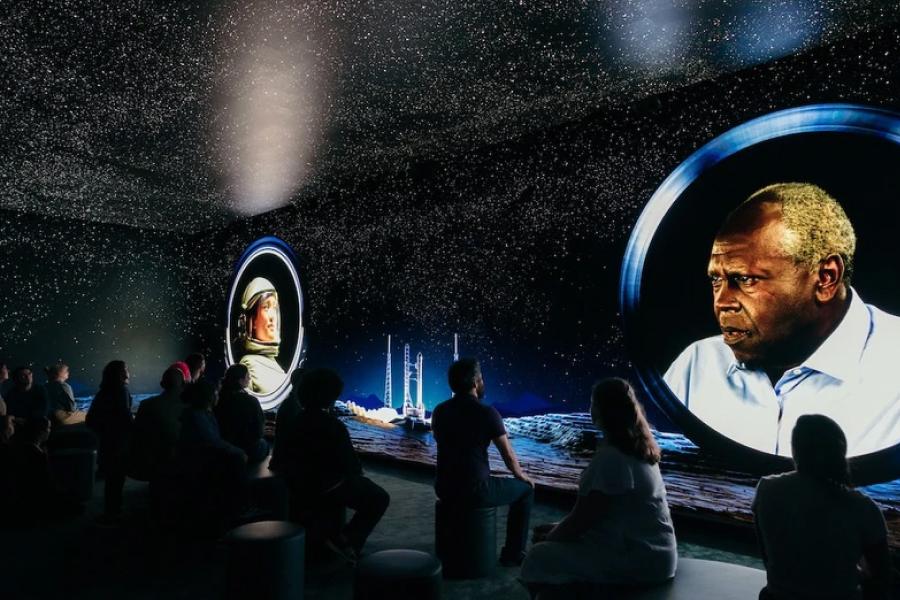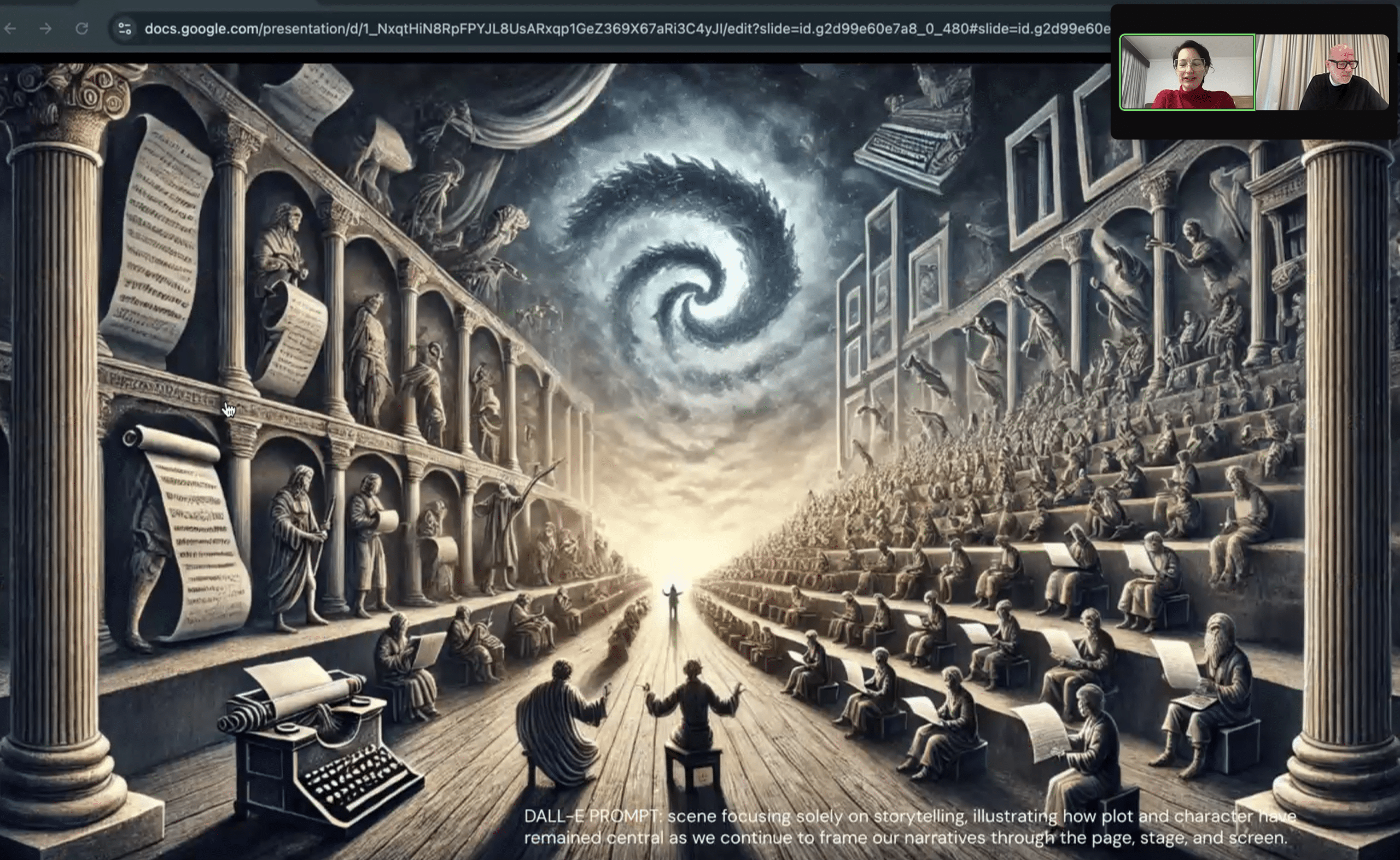What are the different – and best – story shapes to look to when designing your experiences? Is the Hero’s Journey still fit for purpose? And as new forms of technology and storytelling mediums emerge, how are they changing the way we tell stories in our experiences?
This guide, part of our World Experience Glossary, gives an overview of how to design narratives for experiences. Links to relevant think pieces, WXO Campfire reports and experience case studies on the topic of storytelling in experience design are coming soon!
The Hero’s Journey, a concept popularised by Joseph Campbell, remains a cornerstone in modern storytelling, but its application has evolved significantly in contemporary narratives. Leveraging storytelling techniques to create detailed user personas and crafting immersive experiences through compelling narratives, this time-honoured framework, which outlines a hero’s adventure from departure to return, adapts well to the demands of immersive experiences and emerging technologies. Whether it’s through augmented reality (AR), virtual reality (VR), or transmedia storytelling, the principles of the Hero’s Journey offer a robust blueprint for crafting engaging and memorable experiences. In this document, we will delve into how to design narratives for experiences, exploring alternative story shapes, the nuances of immersive storytelling, and the critical role narratives play in today’s business landscape.
The Hero’s Journey in Modern Narratives
Understanding the Hero’s Journey and the User’s Journey
The Hero’s Journey is a narrative structure that outlines a protagonist’s adventure across distinct stages. These stages include the Call to Adventure, where the hero leaves their ordinary world, and the Ordeal, where they face their greatest challenge. The journey concludes with the Return, where the hero comes back transformed. Joseph Campbell identified this pattern in myths and legends worldwide, emphasising its universal appeal. This framework provides a reliable structure for creating compelling stories that resonate with audiences. Modern storytellers adapt the Hero’s Journey to fit different media, ensuring that the core elements of transformation and adventure remain intact. Narrative designers play a crucial role in this adaptation, working closely with story and gameplay teams to integrate storytelling elements seamlessly. Understanding this classic structure is crucial for anyone looking to design narratives for experiences, as it helps create engaging, relatable, and emotionally satisfying stories.
Kurt Vonnegut’s Story Shapes
Kurt Vonnegut, a celebrated American writer, introduced the concept of story shapes, which visually represent the emotional arcs of narratives. Unlike the Hero’s Journey, which follows a set path, Vonnegut’s story shapes are more fluid and adaptable. He identified several common shapes, such as “Man in Hole,” where the protagonist falls into trouble and then climbs out, and “Boy Meets Girl,” which involves a series of ups and downs in a romantic plot. These shapes help writers understand the emotional journey their characters undergo, making it easier to craft compelling stories. By incorporating Vonnegut’s story shapes, modern storytellers can enhance the emotional impact of their narratives, ensuring that they resonate more deeply with audiences. Understanding these shapes is particularly useful when designing narratives for experiences, as it allows for a more nuanced and varied emotional journey. Utilizing storytelling techniques to map these emotional journeys further enhances the impact of the narratives.
Traditional vs. Modern Story Shapes
Traditional story shapes like the Hero’s Journey follow a linear progression with defined stages. Narrative design integrates these traditional and modern story shapes to create engaging experiences. These shapes have stood the test of time due to their simplicity and universal appeal. However, modern storytelling often demands more flexibility to accommodate diverse formats such as interactive media and transmedia narratives. Modern story shapes can be non-linear, branching, or even cyclical, allowing for more complex and engaging experiences. This evolution reflects the changing ways audiences consume content, seeking more immersive and personalised stories. By blending traditional structures with modern variations, storytellers can create narratives that are both familiar and innovative. Understanding the differences and similarities between traditional and modern story shapes is essential for anyone looking to design narratives for experiences, as it enables the creation of stories that are both compelling and adaptable across various platforms.
Alternative Story Shapes
Non-linear Narratives
Non-linear narratives break away from the traditional, chronological storytelling structure. In these narratives, events are presented out of sequence, encouraging the audience to piece together the story themselves. Environmental storytelling is often used in non-linear narratives to convey a story through the game environment, using objects and decorations to suggest a narrative without extra text or dialogue. This format is particularly effective in interactive media, such as video games and immersive theatre, where audience engagement is crucial. Non-linear narratives can offer multiple perspectives, flashbacks, and parallel storylines, making them ideal for complex, layered storytelling. They challenge the audience to stay engaged and think critically, enhancing the overall experience. For those looking to design narratives for experiences, non-linear storytelling provides a versatile tool to create more dynamic and interactive stories. By strategically placing narrative elements, storytellers can lead the audience through a compelling journey that feels both personal and immersive.
Fragmented Storytelling
Fragmented storytelling involves breaking the narrative into disparate pieces that the audience must assemble. User research is crucial in understanding audience needs for fragmented storytelling. Unlike traditional linear stories, fragmented narratives can appear disjointed at first, revealing their full meaning only when the pieces are put together. This technique is often used in mystery and thriller genres, where uncovering the story’s puzzle becomes part of the experience. Fragmented storytelling is highly effective in transmedia projects, where different pieces of the story might be spread across multiple platforms, such as social media, websites, and physical locations. This approach encourages active engagement, as the audience must seek out and piece together the narrative elements. For those interested in how to design narratives for experiences, fragmented storytelling offers a compelling way to engage audiences, making the act of discovering the story as thrilling as the story itself.
Circular Story Structures in Narrative Design
Circular story structures bring the narrative full circle, ending where it began. Narrative designers use these structures to create stories that resonate with audiences by integrating story and game mechanics, creating story engines, and narrativizing systems. This structure provides a sense of closure and symmetry, making it particularly effective for themes of fate, destiny, or cyclical events. In a circular narrative, the protagonist often returns to their starting point but with new insights or changes, highlighting their growth. This format is seen in various forms of literature and film, offering a satisfying and thought-provoking conclusion. Circular stories can be particularly engaging in immersive experiences, where the audience’s journey mirrors the protagonist’s. By understanding how to design narratives for experiences using circular structures, creators can offer a cohesive and emotionally resonant journey. This approach not only ties the story neatly together but also allows for deep thematic exploration, making the narrative memorable and impactful.
Narratives for Immersive Experiences
Why Immersive Storytelling is Different
Immersive storytelling goes beyond traditional narratives by fully engaging the audience’s senses and emotions. Incorporating storytelling enhances user engagement by emotionally involving the audience and guiding them through a brand’s narrative. Unlike passive consumption, such as reading a book or watching a film, immersive storytelling places the audience directly within the story world. This approach requires a different design mindset, focusing on interaction, choice, and engagement. Immersive experiences often leverage technologies like virtual reality (VR) and augmented reality (AR) to create a sense of presence and participation. The narrative must be adaptable, allowing for individual paths and personalised experiences. This makes storytelling more complex but also more rewarding, as it fosters a deeper connection between the audience and the story. Understanding how to design narratives for immersive experiences involves creating multi-layered stories that can respond to audience input, making each experience unique and memorable. The result is a richer, more engaging storytelling experience that resonates on a personal level.
Designing for AR and VR
Designing narratives for AR (augmented reality) and VR (virtual reality) presents unique challenges and opportunities. Unlike traditional storytelling, AR and VR demand a high level of interactivity and immersion. Visual storytelling is crucial in these technologies to create engaging narratives through design elements such as color, typography, layout, images, and videos. The narrative must be flexible enough to allow for user exploration while maintaining a coherent story arc. In VR, the user is fully immersed in a 360-degree environment, making spatial storytelling crucial. Elements such as sound, visual cues, and physical interaction play a significant role in guiding the user through the narrative. In AR, digital elements are overlaid on the real world, blending reality with fiction. This requires seamless integration of virtual content with the physical environment. Understanding how to design narratives for experiences in AR and VR involves creating engaging, interactive, and contextually aware stories. By leveraging the strengths of these technologies, creators can offer unique, memorable experiences that go beyond traditional storytelling methods.
Engaging All Senses through Visual Storytelling
Immersive storytelling excels in engaging all senses, creating a richer, more memorable experience for the audience. Traditional narratives primarily rely on visual and auditory elements, but immersive experiences can incorporate touch, smell, and even taste. In VR, haptic feedback can simulate physical sensations, making the story feel more real. AR can blend virtual elements with physical objects, enhancing the sense of touch. Sound design is also critical, as spatial audio can direct attention and convey emotions more effectively. Scents and tastes are less common but are increasingly explored in experimental storytelling environments, enhancing the sense of immersion. By engaging multiple senses, creators can make the audience feel like an active participant rather than a passive observer. Understanding how to design narratives for experiences that engage all senses can lead to more impactful and engaging stories, helping creators to create stories that make the experience unforgettable.
Transmedia Storytelling
Connecting Multiple Platforms
Transmedia storytelling involves telling a single story or story experience across multiple platforms and formats. Each platform offers a unique piece of the narrative, encouraging the audience to explore and engage with the story in different ways. This approach not only expands the story world but also reaches diverse audience segments. For example, a narrative might start as a film, continue through a series of social media posts, and offer deeper insights via an interactive website or a mobile app. The key to effective transmedia storytelling is ensuring that each platform adds value and enriches the overall narrative. Understanding how to design narratives for experiences across multiple platforms means creating cohesive, interconnected story elements that engage the audience on various levels. This multi-platform approach can deepen audience engagement, making the story more immersive and expansive. Compelling narratives are essential for engaging audiences across different media, as they leverage storytelling techniques to create detailed user personas and craft immersive experiences that evoke emotions, inspire action, and create a lasting impact.
Building a Cohesive Story World
Building a cohesive story world is crucial in transmedia storytelling. Creating meaningful experiences is essential for audience engagement, as it helps connect with users on an emotional level. Each piece of the narrative, spread across different platforms, must fit seamlessly into the larger story. This requires meticulous planning and consistency in elements such as characters, settings, and themes. A well-crafted story world allows the audience to immerse themselves fully, regardless of the platform they are engaging with. For instance, if a character appears in a film, their backstory might be explored in a novel, while their future adventures could unfold in a video game. Every element should contribute to the overall narrative, offering new insights and enriching the audience’s experience. Understanding how to design narratives for experiences that span multiple platforms involves creating detailed, interconnected story elements. This ensures that the story world feels unified and coherent, making the audience’s journey through different media more engaging and satisfying.
Audience Participation
Audience participation is a cornerstone of effective transmedia storytelling. Storytelling techniques, such as creating visual narratives and mapping user journeys, are essential in enhancing audience involvement. By allowing the audience to interact with the narrative, creators can foster a deeper connection to the story. Participation can take many forms, from solving puzzles and contributing to storylines on social media to attending live events and engaging in interactive online content. This active involvement makes the audience feel like they are part of the story world, enhancing their overall experience. For example, a mystery narrative might encourage fans to solve clues posted across different platforms, each leading to the next piece of the story. Understanding how to design narratives for experiences that encourage audience participation involves creating engaging, interactive elements that invite active involvement. This approach not only enriches the story but also builds a loyal and engaged audience, making the narrative more dynamic and memorable.
The Importance of Story in Business
Brand Narratives
Brand narratives are essential for building a strong, memorable brand identity. Incorporating storytelling enhances brand identity by emotionally involving the audience and guiding them through the brand’s narrative. These narratives go beyond mere advertising; they convey the brand’s values, mission, and vision, creating an emotional connection with the audience. A compelling brand story can differentiate a company in a crowded market, making it more relatable and trustworthy. Effective brand narratives often follow a structure similar to traditional storytelling, with a clear beginning, middle, and end. They might highlight the brand’s origin, challenges overcome, and future aspirations. Understanding how to design narratives for experiences in business involves crafting stories that resonate with the target audience and reflect the brand’s core values. By telling a compelling brand story, companies can engage customers on a deeper level, fostering loyalty and driving long-term success. In today’s competitive landscape, a strong brand narrative is not just an asset but a necessity for meaningful engagement.
Emotional Connection with Customers
Creating an emotional connection with customers is vital for any business aiming for long-term success. An effective way to achieve this is through storytelling. Stories evoke emotions, making the brand more relatable and memorable. When customers feel an emotional bond with a brand, they are more likely to remain loyal and even advocate for it. Understanding how to design narratives for experiences that resonate emotionally involves tapping into universal themes like triumph, struggle, and aspiration. For example, a brand might share stories of overcoming challenges or making a positive impact on the community. These narratives humanise the brand, transforming it from a faceless entity into a relatable character in the customer’s life. By fostering an emotional connection, businesses can build stronger relationships with their audience, leading to greater customer satisfaction and loyalty. Emotional storytelling, supported by strong storytelling skills, is, therefore, a powerful tool for any brand looking to deepen its connection with customers.
Case Studies in Successful Storytelling
Examining case studies of successful storytelling can provide valuable insights into how to design narratives for experiences that resonate with audiences. Game design principles are often used in creating engaging brand narratives, integrating storytelling with interactive elements to captivate the audience. One notable example is the “Share a Coke” campaign by Coca-Cola. By personalising bottles with common names, the brand created a story around sharing and connection, which significantly boosted engagement and sales. Another example is Apple’s “Think Different” campaign, which utilised powerful storytelling to align the brand with creativity and innovation, appealing to a wide audience. Nike’s “Just Do It” campaign also stands out, telling stories of perseverance and triumph that resonate deeply with consumers. These case studies demonstrate the power of a well-crafted narrative in building brand identity and fostering emotional connections. By analysing these examples, businesses can learn how to create their own compelling stories, ensuring that their brand stands out in a competitive market and deeply connects with their audience.
To hear experience design insights like these from experience innovators in live Campfires, at our annual Summit and throughout the year as part of the WXO community online, learn more about how to join the WXO today.





